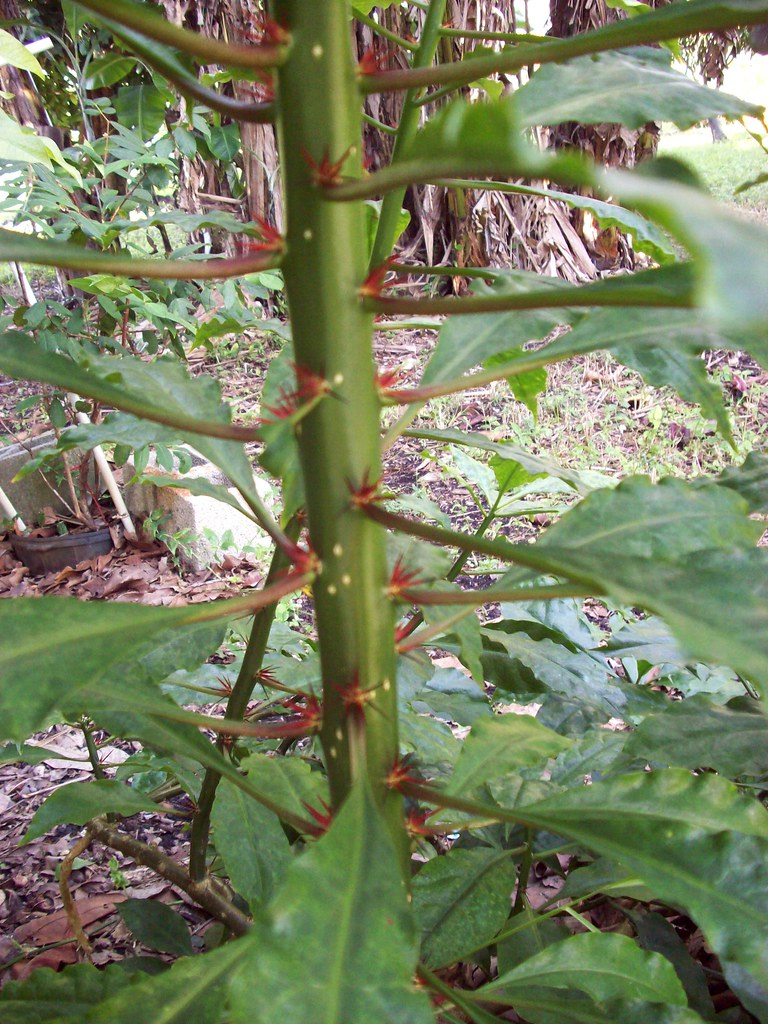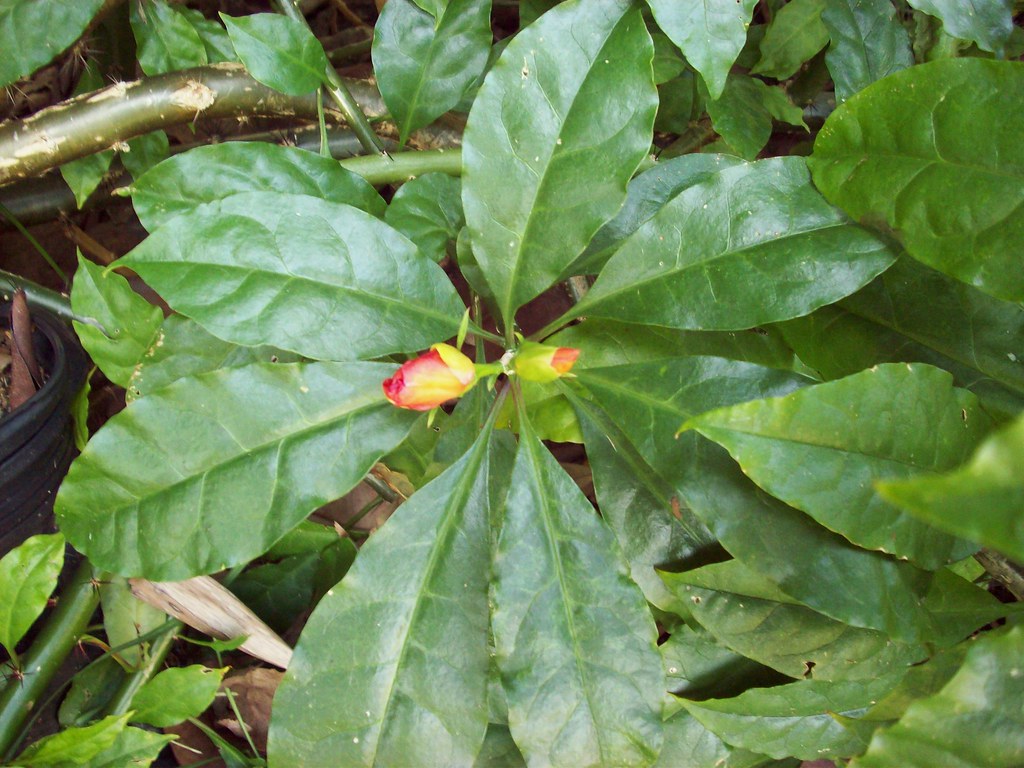
I went to Sundy House in Delray Beach, FL this weekend with fellow fruit enthusiasts Noel Ramos and Jeff & Maria Hagen. Sundy House is a neat little Bed and Breakfast type inn with an amazing collection of tropical fruit trees, bamboos, heliconias, gingers, and a lot more. We were lucky to have our friend Har Mahdeem (Horticulture & Aquatics Manager) give is a tour of the of the property before he started his work day. We toured the grounds and he showed us Sundy House's mature fruiting rare fruit trees, Jackfruit 'Lemon Crunch', Kwai Muk, Ilama, et al. and explained how they came to have all these mature trees on the property. When they built the B&B they searched all over the tri-county area for large specimen trees, then purchased and moved them to Sundy House. They even had to move all the lights on Swinton Ave to get one large tree onto the property. He also told me a little about the history of Sundy House. Sundy House was built in 1902 by John & Elizabeth Shaw and is listed on the National Register of Historic Places. It also has Florida’s only freshwater swimming pond, it uses a bio filter (here's a useful link I don't know which product Sundy House uses. http://www.totalhabitat.com/P&P.html) to clean the water, really an amazing feature. I didn't get to see any of the accommodations or eat in the restaurant, but in the course of my research I have seen it get rave reviews and I would highly recommend seeing the gardens, truly a hidden treasure! Take the time to check it out if you get a chance. Here's some photos I took, as well as the ones of the pool above.








Sundy House by Eric Bronson is licensed under a Creative Commons Attribution-Noncommercial-No Derivative Works 3.0 United States License.
Based on a work at www.flickr.com
Monday, July 13, 2009
Sundy House
Posted by Eric Bronson at 9:21 AM 1 comments
Labels: bamboo, sundy house, tropical fruits
Thursday, July 9, 2009
Cacti Fruits & Flowers
Here are photos of four edible cacti. Each species is unique. Most are native to Central and South America. They make good additions to a tropical, desert or xeriscape garden. They can be propagated by either seed or cuttings, the latter being a quicker way to have a large fruiting specimen. Best of all they all produce delicious fruits.
Cereus repandus
Family: Cactaceae •
Genus: Cereus •
Species: repandus •
Country of Origin: Peru •
Common Names: Peruvian Apple Cactus, Club Cactus •
This fruit was sweet like sugar cane and refreshing sort of like having a drink of water. The edible flesh is white and contains small, edible, crunchy seeds. This is a beautiful columnar cacti up to 30' tall and it is commonly grown as ornamental. The flowers are white, large (6" in diameter) and release an intoxicatingly, heavenly fragrance at night. Here's an amazing photo of the flower. Cereus repandus flower
Cereus repandus flower
Photo by T. McGovern (http://www.flickr.com/people/residualsignal/) original photo @ http://www.flickr.com/photos/residualsignal/891882091/ © 2009 All Rights Reserved
This plant likes to be watered but it needs excellent drainage so a sandy type soil would be best. It will thrive in full or partial sun. The sad news is this species is endangered in it's native habitat. (http://www.cites.org/eng/app/appendices.shtml)
Hylocereus undatus

Family: Cactaceae •
Genus: Hylocereus •
Species: undatus •
Country of Origin: Mexico •
Common Names: Dragon Fruit, Pitaya, Pitahaya •
This is a vining, terrestrial or epiphytic cactus that can grow up to 20' and they can quickly spread through an entire tree. It has night blooming fragrant flower that lasts only one night much like the Cereus repandus. Here's a beautiful picture of the flower. Hylocereus undatus flower
Hylocereus undatus flower
Photo by Alonso Salazar Garibay (http://www.flickr.com/people/asac-cactus/) original photo @ http://www.flickr.com/photos/asac-cactus/3666066260/ © 2009 All Rights Reserved Hylocereus stenopterus flower
Hylocereus stenopterus flower
Photo by Warren Condon (note: this is Hylocereus stenopterus which has unusual pink flowers.)© 2009 All Rights Reserved
This delicious fruit is usually eaten right out-of-hand especially if chilled and cut in half so that the flesh can be eaten with a spoon and, it is considered the best of all cacti fruits. The unopened flower bud can be cooked and eaten as a vegetable. I have a nice cutting growing that I received from Bill Whitman, on the east wall of my house. It has really taken off this year I can't wait for my first fruit!!!! This is a tropical plant although it will tolerate light frost. It will grow in most soil types and will thrive when grown in a medium enriched with organic matter. Full to partial sun for optimal fruiting.
Pereskia aculeata
Family: Cactaceae •
Genus: Pereskia •
Species: aculeata •
Country of Origin: West Indies •
Common Names: Barbados Gooseberry, Grosellero •
This is the beautiful flower of a Barbados Gooseberry. To some people, the flowers are lemon-scented; others say sweet and pungent in odor. This is a scrambling vine that can grow up to 30' in a tree, a lot less though typically in cultivation. The fruit is a yellow to orange berry 2 cm in diameter, edible, containing numerous small seeds. The fruits also have remnants of the calyx on them & sometimes through them as well. When they are fully ripe they easily brush off which gives you an easy way to know when they are ready to eat. Here is a great photo where you can see the calyx growing right through the fruit. Pereskia aculeata fruit
Pereskia aculeata fruit
Photo by Jim West (http://www.flickr.com/people/guaycuyacu/) original photo @ http://www.flickr.com/photos/guaycuyacu/2656478822/© 2009 All Rights Reserved
They are sour but tasty!!! This is truly a unique cacti it belongs to a genus of unusual cacti with spiny non-succulent stems and large leaves. One of the few cacti that still use leaves for photosynthesis. I've started some from seeds they are growing like weeds. Flourishing with little or no care, the plant is drought-tolerant and suffers from over-watering.
Pereskia bleo Pereskia bleo stem & leaves very unusual for cacti!
Pereskia bleo stem & leaves very unusual for cacti! Pereskia bleo unopened flower
Pereskia bleo unopened flower

Family: Cactaceae •
Genus: Pereskia •
Species: bleo •
Country of Origin: Tropical America •
Common Names: Rose Cactus, Wax Rose •
This genus is unlike most other cacti because they have true leaves. Pereskia has now been determined to be the ancestral genus from which all other cacti evolved. This species can grow up to 9 feet tall and has amazing red, rose like flowers. The fruits are oddly shaped as you can see above. Sour and mucilaginous, but I found them tasty!
update 07-22-2009: I just added some new beautiful photos after getting proper permission to use them.
Cacti Fruits & Flowers by Eric Bronson is licensed under a Creative Commons Attribution-Noncommercial-No Derivative Works 3.0 United States License.
Based on a work at www.flickr.com
Posted by Eric Bronson at 10:23 AM 0 comments
Labels: cactaceae, tropical fruits








